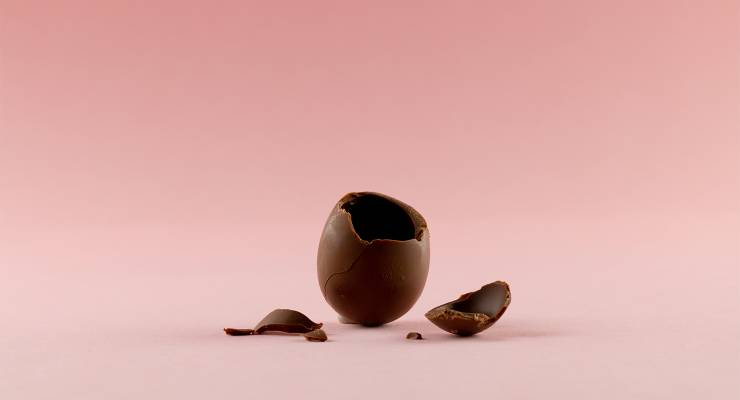
Australia is in the eye of a price-inflation storm, with those among us shopping for Easter eggs discovering prices at levels never before seen. The price of a basic Cadbury bunny has hopped up from $4.25 in 2021 to $4.50 in 2022 and then $5 in 2023. A Lindt bunny nestled in at $5 last year but has multiplied to $6 now.
Chocolate is a perfect representation of how inflation works. The sweet stuff is squeezed up by rising prices for globally sourced ingredients like cocoa, plus domestic price pressures on milk, transport and labour.
Almost all cocoa is sourced from two countries in West Africa — Ghana and Cote d’Ivoire. Those two nations have been soaring recently as cocoa futures have risen. Sugar — the other big ingredient in chocolate — is also very expensive right now, as the next chart shows.
Australia has lots of chocolate factories — we were in the top 15 globally for chocolate imports in 2021. Cadbury alone has two pumping out record volumes, Mars manufactures locally, and there are the likes of Haigh’s and other more boutique concerns. But all that is not enough to sate our nation’s desire, and we are increasingly importing our chocolate (hello to all the Lindt, Choceur and Whittaker’s eaters).
Still, most easter eggs are made locally — it doesn’t make business sense to ship across the world a chocolate product full of air and prone to melting.
Ground zero for Easter eggs — a pagan symbol of spring with a tenuous connection to any resurrection narrative — is Melbourne’s eastern suburbs. Cadbury manufactures millions of easter eggs annually in the suburb of Ringwood, on production lines that also make Picnic and Crunchie bars.
Keeping it creamy
As well as cocoa and sugar, the other big ingredient in chocolate is milk. Dairy prices are the top rising category in the supermarket, according to the ABS, with prices rising more than 15% in the past year. If you tip “a glass and a half of full cream dairy milk” (as per the famous Cadbury slogan) into your product, that’s going to deliver a significant price penalty. Farm gate prices for milk are through the roof in Australia.
And since the company shrank the size of its blocks from 200g to 180g, the Cadbury slogan doesn’t even work anymore. The dreaded shrinkflation — a 10% decrease in block size — means every block now contains a glass and a third of full cream dairy milk, not the old glass and a half. Doesn’t have quite the same ring to it, does it?
The other big costs for running a factory are labour and energy. We all know energy prices have risen a lot, and labour does well too in manufacturing in Australia. Wages growth in manufacturing is running ahead of the Australian average, at 4% a year. You can make $46 an hour as a skilled machinist working in Cadbury’s Tasmanian factory. They run 24 hours a day and you can expect to make even more on night shifts, etc.
But of course, the demand for chocolate eggs is highly seasonal. If you’re willing to wait for just a little until after Easter, appetite for chocolate eggs falls spectacularly and a round of discounting hits. The perfect way to beat inflation.








Price rises for cocoa, sugar and milk do not explain (please, someone, do try out “eggsplain”) the rise in prices for Easter eggs, bunnies and their native Australian equivalents. Price gouging is part of the picture two. One local producer, Haigh’s, has gouged astronomical prices in the range of AU $280-330 for its-usually also high quality-Easter chocolate products. Increases of 300% are not justified by any the rises shown in the graphs, still less by wage rises one a 4% per year for workers. The utter disconnect between Australian markets and appeals by most mainstream economists to how wonderfully our monopolised markets still reveal the universal truth that Adam Smith claimed for competitive markets that the seeker of private profit could serve the public good. Nowhere in the world today reveals what rubbish this universal claim for private profit as much as do Australia’s monopolistic markets.
Proof reading glitches: “two” should read”too” in the sentence “price gouging…”; “The utter disconnect…” should read “There is an utter disconnect…” “private profit as much…” should read “…private profit is as much as…”
There is a logical contradiction in the statement “Australia has lots of chocolate factories — we were in the top 15 globally for chocolate imports in 2021.”
Regarding Cadbury’s glass and a half, some of us are old enough to remember when this applied to a block of chocolate three squares wide (don’t know its weight, but it was in the early 1970’s). The 200 g, now 180 g, block is five squares wide. So, Cadbury’s has been playing funny bu88ers with its slogan for many years, not just recently.
Haighs is a different case from all other chocolate companies. It is the only Australian chocolate manufacture which actually starts its production process from the beans. Hence, it’s production costs will be different. All the others import a semi-produced chocolate and finish it off. It’s a long time since cocoa bean saw the inside of either of Cadbury’s Australian factories.